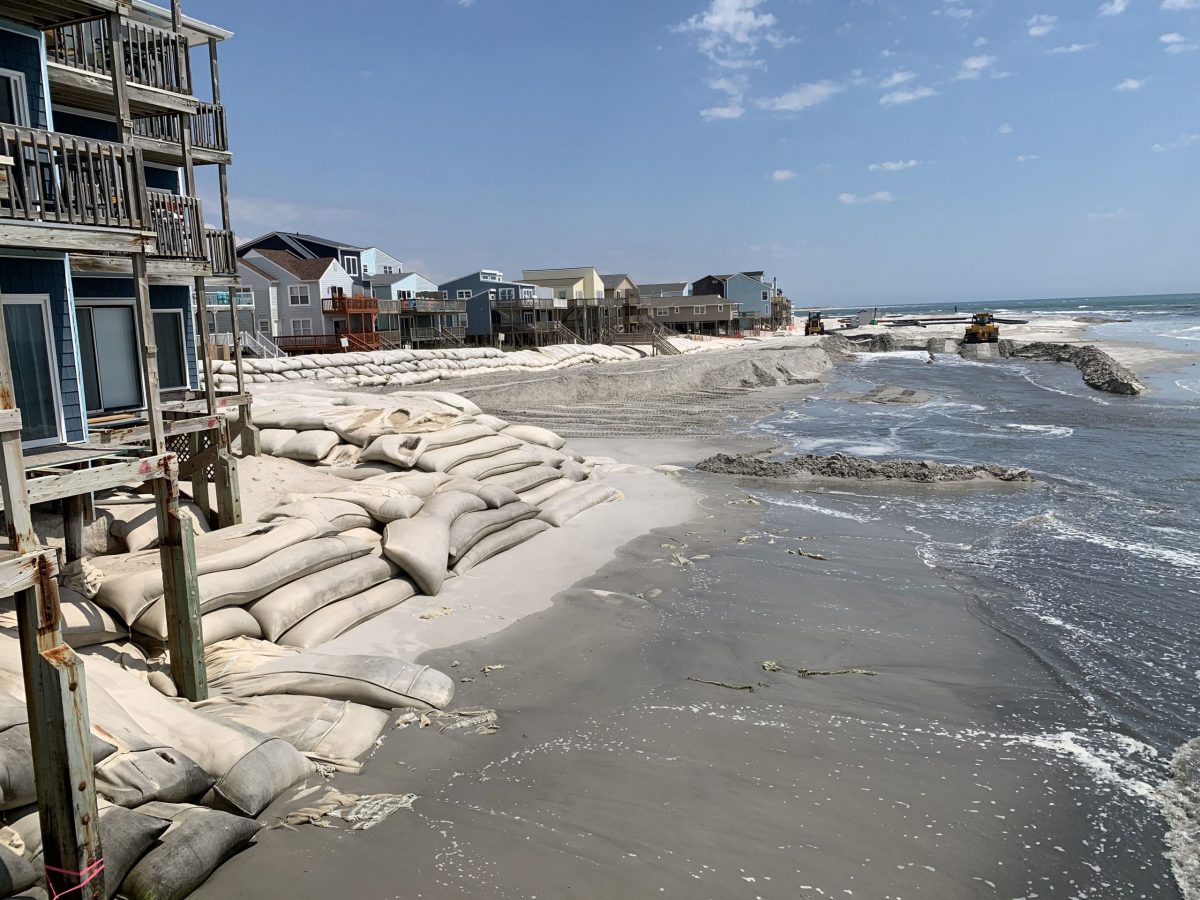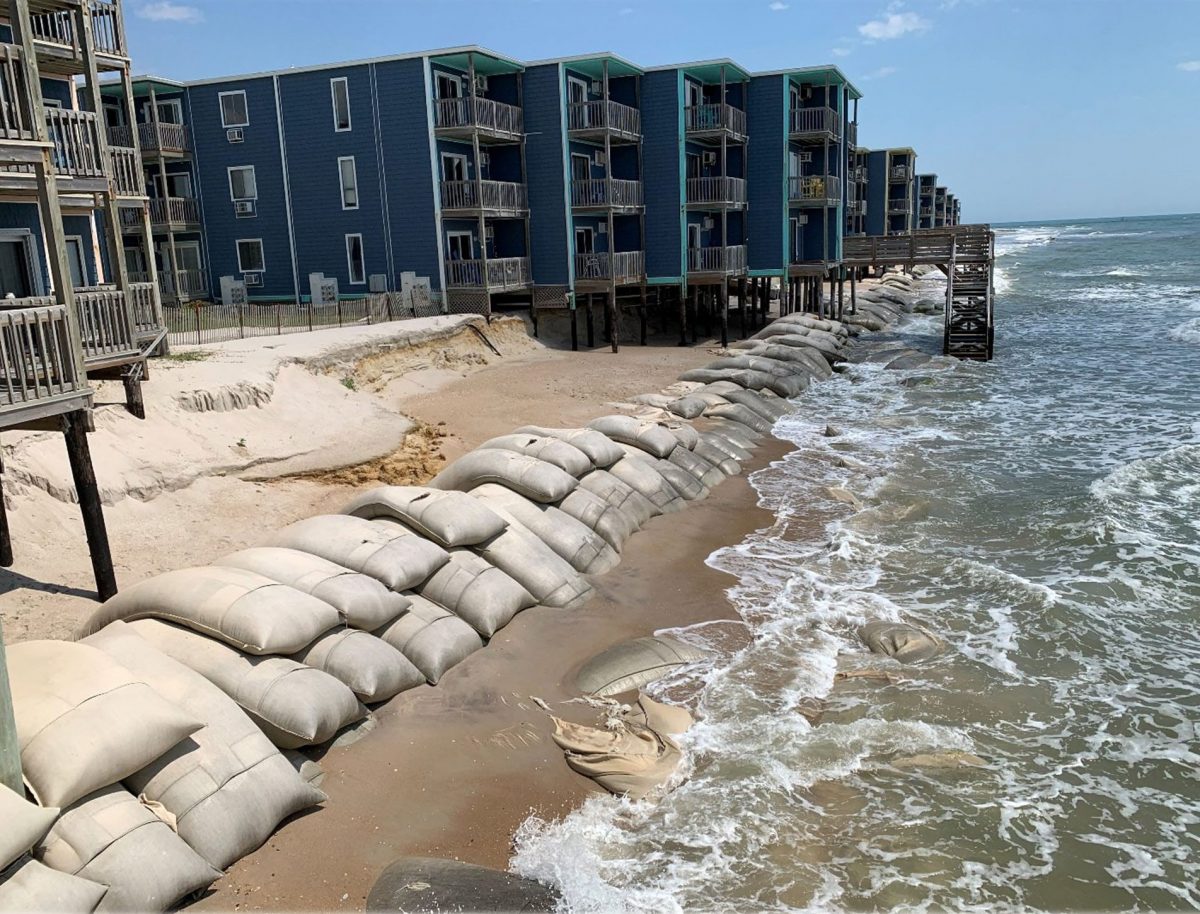
NORTH TOPSAIL BEACH — The oversized sandbags installed years ago as a temporary measure to protect an eight-building condominium complex from accelerated erosion on the town’s northeastern end can remain in place another five years.
During its meeting held online April 28, the Coastal Resources Commission granted a variance to Topsail Reef Homeowners Association Inc. The association manages and owns the common area property at the Topsail Reef condos built in the early 1980s a quarter mile from New River Inlet.
Supporter Spotlight
The oversized sandbags have been in place since 2012 and 2014, when the commission granted variances to the association to use larger-sized sandbags than what is allowed in the rules.
The association was granted a variance to install a larger sandbag structure in 2012 in front of Buildings 1-5. Standard-sized bags were permitted in front of Buildings 6-8. The association made several attempts on a variance to have the sandbag structure in front of Buildings 6-8 match the structure at Buildings 1-5. In November 2014, a variance request was granted to allow the larger sandbag structure for Buildings 6-8 until five years from the initial November 2014 permit, until late 2019.
The Division of Coastal Management received in February 2020 a variance request from the association asking to keep the oversized sandbag structure for five more years. The cancellation of the March 2020 commission meeting because of the Covid-19 pandemic and requests by petitioner to postpone the hearing delayed the request until the April 2021 meeting.
Christy Goebel, assistant general counsel who represented Division of Coastal Management staff, explained during the meeting that the homeowners association had asked to keep the oversized sandbag structures while the town pursues long-term erosion management.
In September 2019 North Topsail Beach entered into a processing agreement with the Army Corps of Engineers. The Corps has been working on an environmental impact statement, or EIS, for the town’s proposed shoreline-protection project, which includes construction of a terminal groin.
Supporter Spotlight
Officials said it will take up to three years to complete the EIS and permitting process that will allow the town to start work on the terminal groin.
Attorney Brian Edes, who represents the homeowners association, explained that when the buildings were built in 1980-81, they conformed with all setbacks, and other regulations.
“More importantly, however, in 1980-81, that area was accreting at an average of 6.1 feet a year as opposed to erosion, so there was no risky building in a place that has this history of accelerated erosion at that time,” he said, adding that in about 1984 the channel in New River Inlet shifted, causing accelerated erosion that continues.
Division documents show that Topsail Reef is in the ocean erodible and high-hazard flood areas of environmental concerns, or AECs. Ocean erodible AECs are beaches and any other oceanfront lands that are subject to long-term erosion and significant shoreline changes and the high-hazard flood AEC covers lands subject to flooding, high waves and heavy water currents during a major storm, according to the division.
“It’s located within the ocean erodible AEC, the long-term average annual erosion rate currently in effect is 2 feet per year based on our 2020 (erosion rate) maps,” Goebel said.
In 2006, the town hired a firm to develop the New River Inlet Management Plan, completed in 2009.
A Coastal Area Management Act, or CAMA, major permit was issued to the town in 2010 authorizing the first phase of that plan, which consisted of repositioning the New River Inlet ocean bar channel to a more central location, and then depositing the dredge material along the shoreline of the north end, including in front of the Topsail Reef property, Goebel said.

The Topsail Reef association decided on sandbags after learning in December 2011 that the town was planning to relocate the channel.
The division then issued in February 2012 to the association a general permit to install 1,500 feet of temporary sandbag revetment along the ocean shoreline in front of the eight buildings but were limited to the size allowed in commission rules, a 20-foot base width and 6-foot height.
Work was underway on the revetment in spring 2012, starting at Building 8 and working east toward Building 1, the farthest east. In April 2012, about 650 feet of sandbag revetment was installed before a storm struck during astronomical high tides.
The storm generally lowered the sand level under the buildings by about 4.3 feet, Goebel said.
In response, an emergency major permit was issued May 2012 allowing the standard sized sandbags instead of the larger size requested. The commission granted the association a variance in May 2012 to allow the larger temporary sandbags in front of buildings 1-5, where work had yet to be completed on the revetment.

In August 2014, the homeowners association submitted variance requests to install the bigger sandbag structure at buildings 6-8, which up to that time was the standard size. The permit was denied because of its inconsistency with commission rules, Goebel said. In September 2014, the association submitted another variance request, which was granted, for bigger bags in front of buildings 6-8.
In November 2014, the commission granted at an expedited hearing the town’s variance petition for larger bags to be placed just north of Building 1 of the complex, extending north to the inlet for about 14,050 feet, Goebel continued.
In 2015, when the legislature expanded the number of allowed terminal groins from four to six, North Topsail Beach considered applying for a permit to construct a terminal groin on the south shoulder of New River Inlet.
In August 2016, the town and the county issued a request for qualified contractors to develop a long-term management plan for New River Inlet, to include but not be limited to the consideration of a terminal groin.
In June 2017, Dial Cordy and Associates Inc. was selected to work with the town in coming up with an alternative approach, addressing urgent problems with New River Inlet.
“The town through its consultants had determined that a terminal groin would provide supplemental protection at the north end,” Goebel said.








